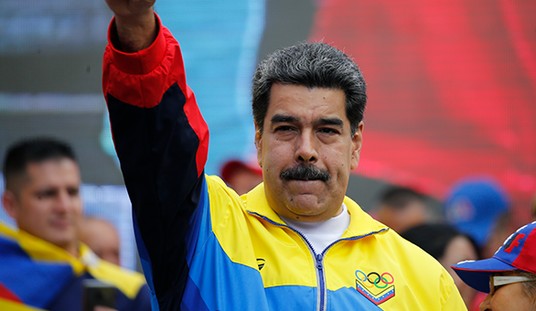This may look like a return of popular protest in Iran, but in truth those demonstrations haven’t entirely stopped. Until recently, though, they mostly stayed out of Tehran. Over the last several days, demonstrations at retailers grew into a massive rally that closed down the city’s Grand Bazaar and then marched on Iran’s parliament:
#BREAKING: Protesters have swarmed Tehran's Grand Bazaar amid nationwide anger over the country's troubled economy – semi-official news agency in Iran pic.twitter.com/Mv1IIPVYv5
— Amichai Stein (@AmichaiStein1) June 25, 2018
Protesters angered by Iran’s cratering economy confronted police officers in front of parliament on Monday, with security forces firing tear gas at them, according to online videos, the first such confrontation after similar demonstrations rocked the country at the start of the year.
The unplanned demonstration came a day after protests forced two major shopping centers for mobile phones and electronics to close in Tehran and after demonstrators earlier closed its Grand Bazaar. …
It wasn’t immediately clear who led the protests. Iran’s semi-official news agencies Fars, ISNA and Tasnim described the protests at the Grand Bazaar as erupting after the Iranian rial dropped to 90,000 to the dollar on the country’s black market, despite government attempts to control the currency rate.
Videos posted to social media showed protesters at the bazaar heckling shopkeepers who refused to close, shouting in Farsi: “Coward!”
A short time later, about 2 kilometers (1.25 miles) from the Grand Bazaar, videos shared by Iranians on social media appeared to show a crowd confronting police at parliament. The videos show tear gas in the air and protesters screaming, “They attacked us with tear gas!” Another man is heard shouting: “Come back!”
The BBC also has video of the protests, which forced most shopkeepers to close their doors. The reimposition of American sanctions has forced a spiraling decline of the Iranian rial, and it has made access to hard currency difficult:
https://instagram.com/p/BkcPOcdD0iJ/?utm_source=ig_embed
Fears about the impact of the US sanctions that will start to be reinstated in August and possibly trigger the collapse of the nuclear deal has led to the rial falling to a record low against the dollar on the unofficial foreign exchange market.
A dollar is currently worth as much as 90,000 rials, compared with 65,000 rials just before Mr Trump’s announcement and 42,890 at the end of 2017.
The currency’s fall also prompted traders at two shopping centres in Tehran that specialise in mobile phones to go on strike in protest on Sunday.
For those who support Trump’s withdrawal from the JCPOA, this outcome will strengthen their argument. However, it’s not clear exactly who this benefits, or who’s behind the shift in protests from the hinterlands to the capital. The Daily Telegraph suspects it might be a hard-liner ploy to get rid of Hassan Rouhani:
However, those protests largely struck Iran’s provinces as opposed to Tehran itself . Analysts believe hard-liners likely encouraged the first protest that took place in Mashhad to weaken the administration of President Hassan Rouhani, a relative moderate cleric within Iran’s politics. The protests then spiraled out of control, with people openly criticizing both Rouhani and Supreme Leader Ayatollah Ali Khamenei.
Rouhani’s government has struggled with the economic problems, which have seen high unemployment. A government-set exchange rate of 42,000 rials to $1 has quickly been surpassed in the black market. On Monday, state television quoted Iranian Central Bank chief Valiollah Seif as saying the government plans to create a parallel market next week to combat the black market.
Meanwhile, some hard-liners have called for new elections or for Rouhani’s civilian government to be replaced by a military-led one. The Fars news agency, believed to be close to Iran’s hard-line paramilitary Revolutionary Guard, made a point Monday to publish an article from the Sobh-e No daily newspaper describing the government as being ready to “bow down to foreign threats and sit at the negotiation table.”
Needless to say, an overtly IRGC-controlled government would not be a pleasant prospect. There are few outcomes in Iran that would be worse than the present status quo but that would be one of those few, although the IRGC already has de facto control of Iranian policy and the economy. However, an open seizure of government, even if not a dramatic change in operational reality, would be the kind of system shock that could quickly backfire. A soft coup of this type may get out of control very quickly, and could not only threaten the mullahs but the IRGC itself. The Green Revolution got started by an incompetently rigged presidential election in 2009 and looked as though it would overthrow the regime, at least until the Obama administration legitimized the election outcome.
For the moment, though, this is just one massive protest. If there is to be any revolution, the dissenters will have to maintain this energy and pick up a lot more supporters. If they succeed at that, it might not matter who started it; it will only matter whose end it brings.
Update: This certainly doesn’t sound like a hardliner effort:
https://twitter.com/SohrabAhmari/status/1011252617492787200
It might have been pushed initially to undermine Rouhani on behalf of the IRGC, but if this is true, it is morphing into something else altogether.








Join the conversation as a VIP Member